Investigation on Sloshing Effects of Tank Liquid on the FLNG Vessel Responses in Frequency Domain
2014-06-07
(State Key Laboratory of Ocean Engineering,Shanghai Jiao Tong University,Shanghai 200240,China)
Investigation on Sloshing Effects of Tank Liquid on the FLNG Vessel Responses in Frequency Domain
ZHAO Wen-hua,HU Zhi-qiang,YANG Jian-min,WEI Yue-feng
(State Key Laboratory of Ocean Engineering,Shanghai Jiao Tong University,Shanghai 200240,China)
FLNG is a new type of floating offshore unit,which has a ship-type FPSO hull equipped with LNG storage tanks and liquefaction plants.The coupling effects and interactions between ship motion and inner-tank sloshing are investigated with the help of the code WADAM in frequency domain.A unified approach where the interior wetted surfaces of the tanks are included as an extension of the conventional defined exterior wetted surface of the body is adopted,in which all of the tank and hull wetted surfaces form a large global boundary surface.RAOs(Response Amplitude Operator)for the six-degree-freedom of the hull are obtained with and without considering the tanks.Comparisons between the results with and without considering the tanks are made and significant characters regarding effects of sloshing flow on the global response of the FLNG vessel are observed.
FLNG;sloshing;coupled analysis;free surface
Biography:ZHAO Wen-hua(1986-),male,Ph.D.student of Shanghai Jiao Tong University.
1 Introduction
For several decades,natural gas was merely a byproduct of oil production.Owing to its advantages,compared with other fossil fuel sources(e.g.oil and coal),the demand for natural gas is expected to increase sharply in the future.This makes the exploitation of stranded offshore gas fields attractive.However,most of the stranded gas fields locate in the sites with deep water depth and remote from the onshore infrastructure or existing offshore pipelines.As a result,FLNG,a new type of offshore unit is proposed and it has been developed as an alternative to long pipelines to onshore LNG liquefaction plant for stranded offshore fields,and research on related technology shows promising for the exploitation of the stranded gas fields[1-4].
Owing to the economical and operational reasons,FLNG is expected to be much larger than the conventional FPSO already used in oil field,in which case the sizes of the inner tank are also correspondingly large.As an offshore structure,FLNG would be located in the designated place during its service life.FLNG would be exposed to work in complex sea environments and experience different filling levels of its inner tanks.Complex sea environments together with different filling levels can cause significant sloshing problem,which would affect the motion responses of the FLNG vessel.The tank liquid flow is altered by the vessel motion in return.This is of great concern for the FLNG operation in the production site and offloading operation of LNG carriers close to LNG terminal.
The coupling effect between ship motion and inner-tank-liquid sloshing has been studied by Molin et al[5],Malenica[6],Rognebakke and Faltinsen[7],and Newman[8]based on linear potential theory in the frequency domain.In time domain,Kim[9]studied the effect of sloshing to ship motion with 2-D sloshing calculation and Lee[10]studied sloshing effect on ship’s roll motion with 3-D calculation of single tank with 3D FDM calculation.
As mentioned above,coupled tank/ship motions have been studied by Rognebakke and Faltinsen[7],with nonlinear analyses of the interior flow in the tanks,and by Molin et al[5]and Malenica et al[6]with linear analyses.In these works,the tank dynamics are analyzed separately from the exterior radiation and diffraction problems.The solution of the coupled equations of motion is obtained by combining the hydrodynamic forces for the tanks with the vessel’s added mass,damping,and exciting forces.When the tank motions are linearized,their only effect on the vessel’s motions is to modify the added mass.Recently,a unified approach has been adopted to the panel code WAMIT to analyze the coupled tank/ship motions by Newman[8].In this approach,the interior wetted surfaces of the tanks are included as an extension of the conventional computational domain defined by the exterior wetted surface of the body.All of the tank and hull wetted surfaces form a unified large global boundary surface.The principal modification is to impose the condition that the separate fluid domains are independent.This is achieved trivially,by setting equal to zero all coefficients of the linear system for the potential where the source and field points are in different fluid domains.This is equivalent to form separate linear equations for each domain,and concatenate these into one global system in a block-diagonal manner.The exterior free-surface Green function is used for each domain,with vertical shifts of the coordinates corresponding to the free-surface elevation in each tank.Using this approach,coupled analysis on the FLNG equipped with 10 LNG tanks is carried out.
In order to investigate the sloshing effects of the inner-tank-liquid on the global motion responses of the FLNG vessel,both numerical simulations considering the tank sloshing effects and ignoring them are conducted.Characters of the sloshing effects on the global motion responses of the FLNG vessel are observed and summed up through the comparison results between motion RAOs obtained with and without considering the tank sloshing effects.
2 Mathematical formulation
2.1 Motion formulae
The target studied a FLNG vessel equipped with 10 partially filled LNG tanks,and with zero forward speed.In the simulation,two coordinate systems such as tank-fixed and ship-fixed coordinate systems,are defined.The potential theory is adopted to describe the ship motion in waves.Decomposing the total disturbance velocity potential into an incident flow component de-noted as Φ and a scattering potential component denoted as Ψ ,the boundary value problem in the realm of linear theory is written as follows:

Radiation condition at infinite field
where η and n indicate scattering wave elevation and the normal vector on the body surface respectively.
The equation of the rigid body motions in six degree of freedom can be set up as follows:

where Mijare the components of the generalized matrix for the ship hull,aij(ω ) is the added mass matrix,C(ω ) is wave damping matrix,and K is the hydrostatic restoring stiffness matrix,and F(ω ) is external force vector due to wave,mooring,sloshing,etc.In frequency domain where linear superposition rule can be applied,nonlinear term in the system needs to be linearized.For example,viscous roll damping which plays an important role in ship motion can be included by means of critical damping.And sloshing effect,even though strongly nonlinear phenomenon,can also be linearized and implemented by adding inertia and hydrostatic force into each terms in Eq.(4).The body motions corresponding to the first-order and second-order wave exciting forces can be expressed as:

where RAO()
ω is the Response Amplitude Operator which can be expressed as:

Once the RAO()ω is obtained,response of the structure in random waves can also be obtained using linear spectrum analysis:

where Sξ(ω ) is the response spectrum of the ship motion,S(ω ) and(ω ) are the firstand second-order wave force spectra,respectively.
2.2 Sloshing effect
When sloshing effect is taken into consideration in frequency domain,two facts need to be considered:inertia of sloshing fluid and restoring stiffness correction due to the inner free surface inside the tank.
The 3D panel method is also used in the calculation of the added mass of sloshing fluid.The boundary value problem for the tank sloshing can be formulated as follows:

The presence of inner free surface causes a change of FLNG hull’s restoring stiffness.The change of restoring force due to the inclination of the ship is illustrated in Fig.1.
When the center of gravity of inner fluidis moved to a new positiondue to ship inclination of φ,the whole ship’s restoring force will be decreased as much as the inner free surface’s contribution[11]:


Fig.1 Restoring force correction due to inner fluid



It can be observed that change of the restoring force due to inner fluid is affected by only second moment of inertia of inner free surface with respect to rotational axis and density of inner tank fluid,and it is not affected by filling level or location of tanks.
2.3 Coupling two problems in frequency domain
Under the assumption of small-amplitude motions of ship and liquid flow,ship motion and sloshing problems can be coupled in the frequency domain based on linearized potential flow theory.In order to take into account of the viscous effects,the linear equivalent damping co efficient(ω ) is added to C44(ω )[11].

where γ is the damping ratio of the system damping divided by critical damping.The body motion and force vectors can be written as:

The coupling of ship motion and liquid sloshing can be investigated by adding the hydrodynamic force vectors of inner fluid motion to the right hand side of Eq.(4),and Eq.(4)is transformed into the following equation:

where Fs()trepresents the force vector due to liquid motion.Only the inertia force of the sloshing is considered,since there is no radiation damping for the internal problem.

where Mas()
ω is sloshing fluid’s added mass.The hydrostatic effect of internal fluid can be included as the reduction of restoring force due to the presence of the inner free-surface.
The resulting coupled equation of motion can be written as:

Based on the theories mentioned above,coupling analysis between ship motion and sloshing flow of inner tank liquid can be carried out.RAOs of the six-degree of freedom motions are expressed in the following section.
3 Hydro model
Before the starting of the hydrodynamic analysis,3-D hydro models were generated.In this paper,a FLNG is chosen as the object vessel.It has a length of 392 meters,a breadth of 69.0 meters and a depth of 35.7 meters.In addition,the FLNG is also equipped with ten tanks,each of which has the same dimensions of 39m(L)×29m(B)×28m(H).It is designed to be located in the site with water depth of 1 500 meters in South China Sea and moored by 12 mooring lines attached to the external turret.In the hydrodynamic simulation,a case of 26%filling level is selected with the mean draft of 13.24 meters.
The panel model on which the external wave loads are applied is presented in Fig.2.Detail of grid generation can also be observed in Fig.2.Mass model is divided into two parts:mass model of the hull shown in Fig.3 and the mass model of the inner tanks illustrated in Fig.4.Mass model of the hull which represents the mass of the FLNG hull is generated by beam ele-ments.Correspondingly,mass model of the tanks represents the inner tank on which the sloshing effects are applied.The hydro model adopted in this simulation is the combination of panel model and mass model which is expressed in Fig.5.
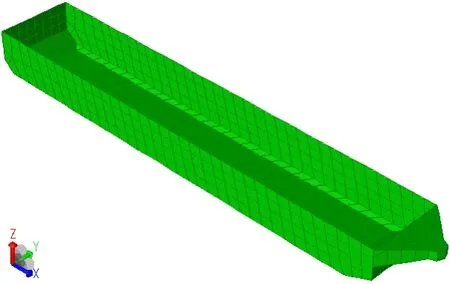
Fig.2 Panel model

Fig.3 Mass model of the hull

Fig.4 Mass model of the tanks
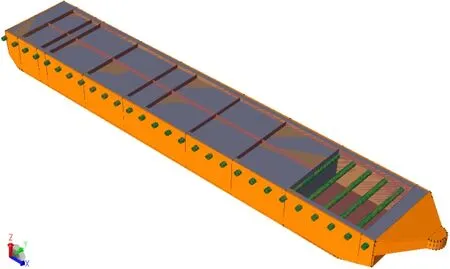
Fig.5 Hydro model
The sloshing flow of inner tank liquid would become strongly nonlinear near the resonance between the sloshing flow and excitation forces.Those strong nonlinear phenomena include wave breaking,particle splash,jet flow,and impact occurrence.As we all know,it is extremely difficult to take into account all these phenomena in frequency domain due to their nonlinearities.Fortunately,these local flows seem not to play an important role in global fluid motion.In this perspective,the free-surface boundary is assumed as a single-valued function.Another nonlinear phenomenon is the viscous roll damping.It is chosen as 3%of the critical damping in the simulation.
4 Results and discussions
Based on those theories as mentioned above,motion RAOs of six-degree of freedom for the FLNG vessel are obtained.Comparison results of the motion RAOs with and without considering the tanks for the case of heading sea are shown in Fig.6.Fig.7 represents the motion RAOs with and without considering the tanks for the case of beam sea.The coupling effects between the ship motion and the sloshing flow are observed through the comparison of the motion RAOs.
Overall,it can be observed that motion RAOs of the six-degree of freedom with tanks perform the same trend as those without tanks.In this perspective,the sloshing flow of the inner tank liquid affects the ship motion in a global level.It will only affect the amplitude of the motion response,but will not change the form of motion response.
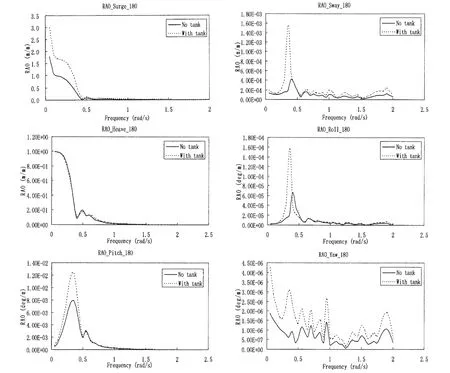
Fig.6 RAOs of FLNG with and without tanks in heading sea
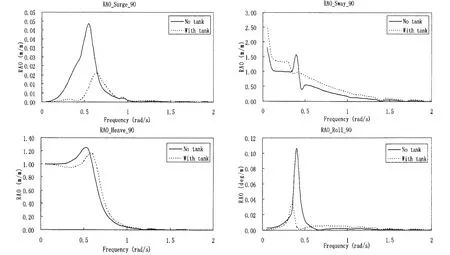

Fig.7 RAOs of FLNG with and without tanks in beam sea
It can be concluded that the sloshing flow of the inner tank liquid can significantly affect the response amplitude of the ship motion near certain frequency,which is known as resonance frequency.And the effect becomes smaller in the areas far away from the special frequency.This significant motion response may be due to the resonant effect of the sloshing flow and the excited forces.
Among the RAOs of the six-degree of freedom,RAO for heave motion with tanks keeps almost the same as that without tanks.This indicates that the sloshing flow of the inner tank liquid has less effect on the heave motion than any other motion modes.This can be explained as follows:in a single mode of heave motion without any other motion modes,the inner tank liquid performs just as a mass block which has no sloshing effect at all.The presented minor effect on the heave motion can be expressed as one of the coupled effects of other motion modes.
Another phenomenon of great interest is that the sloshing flow of the inner tank liquid enhances the motion responses of the FLNG vessel in heading sea,while motion responses are reduced due to the effect of the sloshing flow in beam sea.This implies that the sloshing effect of inner tank liquid on the global motion of the FLNG is related to the relative angle between the vessel heading and the direction of the wave propagation.This divergent effect of the sloshing flow may be due to the different phases between the wave-excitation and sloshing-induced moments[12].In the case of a given filling level condition,when the wave-excitation and sloshing-induced moments have a phase difference within a range,the resultant motion can be increased due to sloshing flow.While the phase difference is out of the range,the resultant motion can be decreased owing to sloshing flow.This should be further studied and verified.
Moreover,characteristic values for the motion RAOs in both heading and beam seas are illustrated in Tab.1 and Tab.2 respectively.The characteristic values include the response frequency and its corresponding motion response.In order to provide a direct performance,column diagrams with each type motion response in a bundle were plotted in Fig.8 and Fig.9.Comparisons are made for each heading case between results with and without tanks.It is found from both Tab.1 and Tab.2 that the resonance frequency changes for the effect of the sloshing flow,compared with the case without tanks.This phenomenon is of significant use for the operation of the FLNG system in the real sea conditions.A further conclusion can be observed from the column diagrams that the resonance frequency is shifted to be smaller in sway,roll and yaw motions in both heading and beam seas;the resonance frequency is shifted to be larger in surge,heave and pitch motions in both heading and beam seas.Further study should be carried out on the perspective.

Tab.1 Characteristic value for heading sea
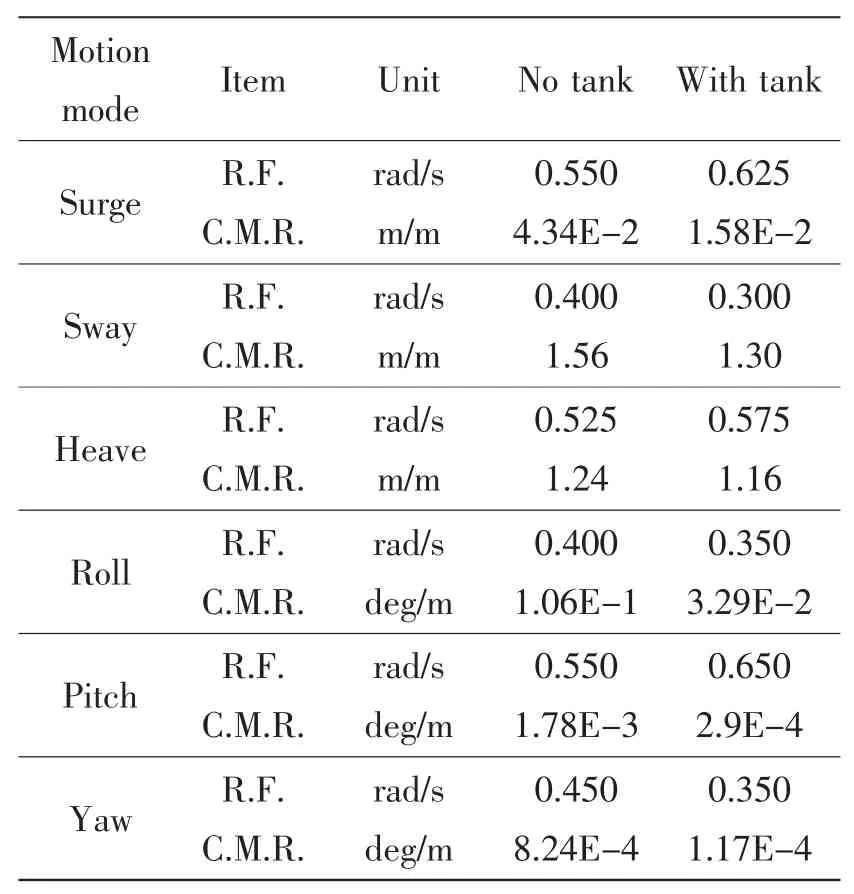
Tab.2 Characteristic value for beam sea

Fig.8 Resonance frequency in heading sea
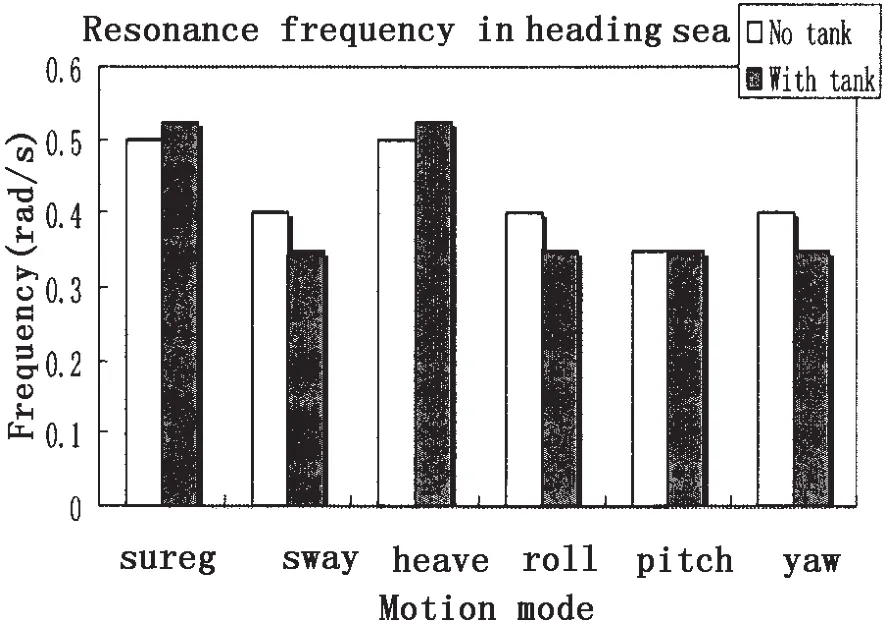
Fig.9 Resonance frequency in beam sea
5 Conclusions
The numerical simulations have been performed by adding the 3D panel method for interior problems in frequency domain.The inner-tank-sloshing effect is characterized by increase in added mass,decrease in restoring forces of sloshing fluid,and the hydrostatic correction of inner free surface.Although the frequency domain analysis is based on linear potential theory,the results generally produce the qualitative trend of the coupling effect between inner-liquid and ship motions.
Motion RAOs of the FLNG have been obtained for both heading and beam seas.Comparisons of the RAOs with and without considering the tanks are also carried out.Important phe-nomena regarding interaction of sloshing flow and ship motion are found which can be described as follows:
(1)The heave-motion amplitudes are much less affected by sloshing flow of the inner-tank liquid compared to any other motion mode in both heading and beam sea conditions.
(2)In a given filling level condition,effects of tank sloshing on the global response of the FLNG can be significantly affected by wave headings.Tank sloshing can both increase and reduce the global response of the FLNG vessel due to different wave headings.
(3)Resonance frequency can be shifted due to the effect of tank sloshing.
As mentioned above,the numerical simulation is based on linear potential theory.Nonlinear phenomena such as viscous damping and nonlinear sloshing flow are not taken into account in this paper.Further study on the coupled analysis between the ship motion and the sloshing flow considering the nonlinearity should be carried out.The free surface should also be further investigated.
[1]Kim J W,O’Sullivan J,Steen A,Halkyard J.Global performance and sloshing analysis of a new deep-draft semi-submersible LNG FPSO[C]//Proceedings of 28th International Conference on Offshore Mechanics and Arctic Engineering.Estoril,Portugal,2008,OMAE2008-58001.
[2]Mravak Z,de Lauzon J,Chung Yun-Suk,Diebold L.Strength assessment of membrane LNG tank structure based on direct calculation of structural response[C]//Proceedings of 28th International Conference on Offshore Mechanics and Arctic Engineering.Hawaii,USA,2009,OMAE 2009-79956.
[3]Graczyk M,Moan T.Structural response to sloshing excitation in membrane LNG tank[C]//Proceedings of 28th International Conference on Offshore Mechanics and Arctic Engineering.Hawaii,USA,2009,OMAE2009-79722.
[4]White J,Longley H.FLNG technology shows promise for stranded gas fields[J].OFFSHORE,2009:78-79.
[5]Molin B,Remy F,Rigaud S,de Jouette Ch.LNG FPSO’s:Frequency domain,coupled analysis of support and liquid cargo motion[C]//Proceedings IMAM conf.Rethymnon,Greece,2002.
[6]Malenic Š,Zalar M,Chen X B.Dynamic coupling of seakeeping and sloshing[C]//Proc.13th Int.Offshore and Polar Eng.Conference.Hawaii,USA,2003.
[7]Rognebakke O F,Faltinsen O M.Coupling of sloshing and ship motions[J].Journal of Ship Research,2003,47(3):208-221.
[8]Newman J N.Wave effects on vessels with internal tanks[C]//20th Workshop on Water Waves and Floating Bodies.Spitsbergen,Norway,2005.
[9]Lee D H,Kim M H,Kwon S H,Kim J W,Lee Y B.A parametric and numerical study on LNG-tank sloshing loads[C]//Proc.15th Int.Offshore and Polar Eng.Conference.Seoul,Korea,2005.
[10]Lee S J,Kim M H,Lee D H,Kim J W,Shin Y S,Kim Y H.The effects of LNG-tank sloshing on the global responses of LNG-carriers[C]//Proc.16th Int.Offshore and Polar Eng.Conference.San Francisco,USA,2006.
[11]Lee Seung Jae.The effects of LNG-sloshing on the global responses of LNG-carriers[D].Ph.D.Dissertation,Texax A&M University,USA,2008.
[12]Kim Y,Nam B W,Kim D W,Kim Y S.Study on coupling effects of ship motion and sloshing[J].Ocean Engineering,2007,34:2176-2187.
频域范围内液舱晃荡对FLNG运动影响的研究
赵文华,胡志强,杨建民,魏跃峰
(上海交通大学海洋工程国家重点实验室,上海200240)
FLNG是一种新型的浮式海洋结构物,其外形与FPSO相似并配备天然气的液化装置以及LNG储罐。FLNG概念的出现使得海上边际油气的开发不再依赖于长距离的管道运输,从而节约了此类油气田的开发成本。文中基于WADAM并针对液舱晃荡与船体运动之间的相互影响进行了频域范围内的研究,在研究过程中将液舱内湿表面包含于船体外湿表面中从而形成一个统一的边界表面。通过计算得出考虑液舱晃荡与忽略液舱晃荡两种情况下的六自由度运动的RAO。对于两种情况下的计算结果进行分析研究,从而得到液舱晃荡对船体运动影响的重要规律。
大型浮式液化天然气船;晃荡;耦合分析;自由表面
U661.32
A
赵文华(1986-),男,上海交通大学船舶海洋与建筑工程学院博士研究生,zwzldh@163.com;
魏跃峰(1981-),男,上海交通大学船舶海洋与建筑工程学院博士研究生。
U661.32
A
1007-7294(2011)03-0227-11
date:2010-12-24
Supported by China National Significant Science&Technology Research Program(Grant No.2008ZX05026-006)
This work was financially supported by China National Significant Scientific and Technology Major Project(Grant No.2008ZX05026-006).This support is gratefully acknowledged by the authors.
胡志强(1976-),男,上海交通大学船舶海洋与建筑工程学院讲师;
杨建民(1958-),男,上海交通大学船舶海洋与建筑工程学院教授/博士生导师;
猜你喜欢
杂志排行
船舶力学的其它文章
- Vessel Motion Effects on Nonlinear Dynamics of Deepwater Drilling Riser
- A Rule of Spatial Sampling on Cylindrical Shells for Predicting Radiated Acoustic Field
- Effect of Plastic Zone Size Induced by a Single Dwell Overload on the Fatigue Crack Growth Rate under Cyclic Loading
- Research on Multidisciplinary Design Optimization Methods for Cylindrical Underwater Vehicle
- An Analysis of Mean Wave Drift Forces of FPSO Systems by Higher-order Boundary Element Method
- Study of Vortex Induced Characteristics of Multi-columns with Low Mass Ratio
